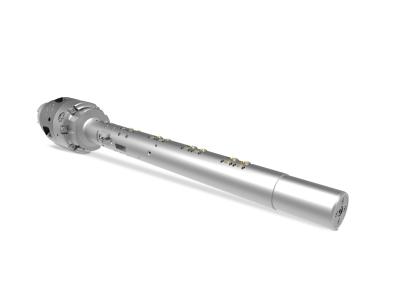
To make the fine machining of the crankshaft bearing journals on a machining center economical, line boring bars are often used. With an innovative concept, MAPAL has been able, in collaboration with a machine manufacturer, to optimize this processing in several ways: Compared with conventional line boring bars, quality can be increased, processing can be sped up, and tool service life can be increased, all thanks to the new line boring bars with compensation-enabled cutting edges.
The new line boring bars simultaneously act as actuating tools. The cutting edges are controlled to retract into the tool into the storage slots via an inner tie rod. Only in this way can all the separators of the crank shaft bearing lanes be machined simultaneously in one pulling cut. Without the control of the cutting edge, a collision of the workpiece and the cutting edge upon retracting would be inevitable. The drawbar can be operated through different systems, such as the mechatronic systems (e.g. TOOLTRONIC), via a coolant pressure system or an in-house system of the machining center.
A manual adjustment of the cutting inserts to compensate for wear causing with machine downtime is not necessary, thanks to the new implementation of the line boring bars. This is because according to each individual application, the cutting edges are measured directly in the machining center with an integrated measuring rod or externally, and the actual value entered into the control of the machining center. The cutting edges will be readjusted accordingly and the determined wear will automatically be compensated for.
Contact Details
Related Glossary Terms
- boring
boring
Enlarging a hole that already has been drilled or cored. Generally, it is an operation of truing the previously drilled hole with a single-point, lathe-type tool. Boring is essentially internal turning, in that usually a single-point cutting tool forms the internal shape. Some tools are available with two cutting edges to balance cutting forces.
- coolant
coolant
Fluid that reduces temperature buildup at the tool/workpiece interface during machining. Normally takes the form of a liquid such as soluble or chemical mixtures (semisynthetic, synthetic) but can be pressurized air or other gas. Because of water’s ability to absorb great quantities of heat, it is widely used as a coolant and vehicle for various cutting compounds, with the water-to-compound ratio varying with the machining task. See cutting fluid; semisynthetic cutting fluid; soluble-oil cutting fluid; synthetic cutting fluid.
- machining center
machining center
CNC machine tool capable of drilling, reaming, tapping, milling and boring. Normally comes with an automatic toolchanger. See automatic toolchanger.
